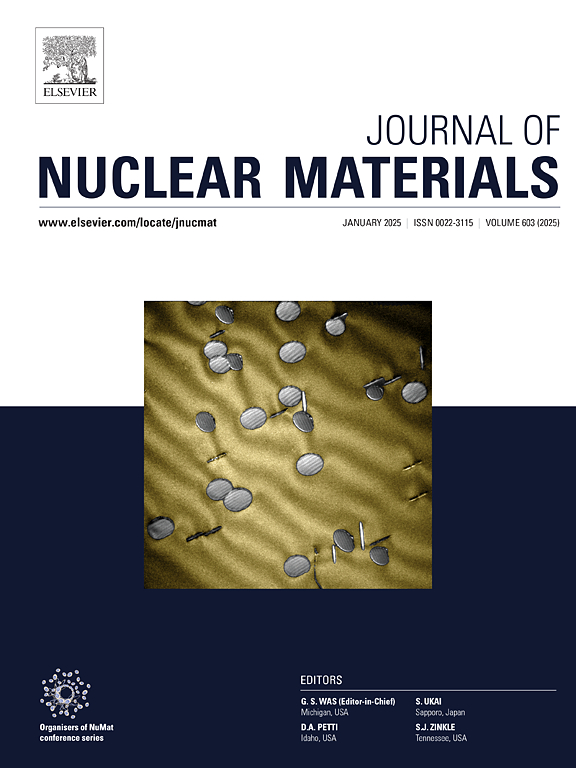Structure evolution and tin redistribution during oxidation of Zircaloy-4 at 500°C
IF 2.8
2区 工程技术
Q3 MATERIALS SCIENCE, MULTIDISCIPLINARY
引用次数: 0
Abstract
Zirconium (Zr) alloys are widely used as fuel cladding in nuclear power reactors due to their thermal stability, mechanical durability, corrosion resistance, and low neutron absorption cross-section. However, their performance is challenged by oxidation in reactor environments, making the study of Zr alloy corrosion behavior crucial for ensuring the safety, longevity, and economic viability of nuclear power systems. While the oxidation behavior of Zr-based cladding materials has been extensively studied since the 1950s, a mechanistic understanding into the relationship between structure evolution, solute element redistribution, and properties remains elusive. Valuable insights may be obtained through advanced experimental methods, such as in-situ and high resolution microscopy techniques. In this study, the oxidation behavior of Zircaloy-4 at 500 °C in O2 is characterized using a multimodal advanced characterization approach. Using in-situ X-ray diffraction, the phase evolution from metastable to stable oxides is tracked in real time. Complementary high-resolution techniques, including electron microscopy and atom probe tomography, reveal nanoscale insights into the microstructural changes and solute redistribution across the oxide/metal interface. Nanohardness mapping across the oxide/metal interface highlights localized mechanical property variations that may be linked to changes in microstructure and crystal structure within the oxide layer. These findings offer valuable insights into the microstructure and property evolution of Zircaloy-4 during oxidation, contributing to a better understanding of microstructural changes in Zr-based alloys under oxidative environments.
500℃氧化锆-4的结构演变与锡重分布
锆(Zr)合金具有热稳定性好、机械耐久性好、耐腐蚀、中子吸收截面小等优点,被广泛应用于核反应堆的燃料包壳中。然而,它们的性能在反应堆环境中受到氧化的挑战,因此研究Zr合金的腐蚀行为对于确保核电系统的安全性、寿命和经济可行性至关重要。自20世纪50年代以来,人们对锆基包层材料的氧化行为进行了广泛的研究,但对结构演变、溶质元素再分配和性能之间关系的机理理解仍然难以理解。通过先进的实验方法,如原位和高分辨率显微镜技术,可以获得有价值的见解。在本研究中,使用多模态高级表征方法表征了Zircaloy-4在500°C O2中的氧化行为。利用原位x射线衍射,实时跟踪了从亚稳态到稳定氧化物的相演化过程。互补的高分辨率技术,包括电子显微镜和原子探针断层扫描,揭示了纳米尺度的微观结构变化和溶质在氧化物/金属界面上的重新分配。跨越氧化物/金属界面的纳米硬度映射突出了局部力学性能的变化,这些变化可能与氧化物层内微观结构和晶体结构的变化有关。这些发现为研究氧化过程中zr -4的显微组织和性能演变提供了有价值的见解,有助于更好地理解氧化环境下zr基合金的显微组织变化。
本文章由计算机程序翻译,如有差异,请以英文原文为准。
求助全文
约1分钟内获得全文
求助全文
来源期刊

Journal of Nuclear Materials
工程技术-材料科学:综合
CiteScore
5.70
自引率
25.80%
发文量
601
审稿时长
63 days
期刊介绍:
The Journal of Nuclear Materials publishes high quality papers in materials research for nuclear applications, primarily fission reactors, fusion reactors, and similar environments including radiation areas of charged particle accelerators. Both original research and critical review papers covering experimental, theoretical, and computational aspects of either fundamental or applied nature are welcome.
The breadth of the field is such that a wide range of processes and properties in the field of materials science and engineering is of interest to the readership, spanning atom-scale processes, microstructures, thermodynamics, mechanical properties, physical properties, and corrosion, for example.
Topics covered by JNM
Fission reactor materials, including fuels, cladding, core structures, pressure vessels, coolant interactions with materials, moderator and control components, fission product behavior.
Materials aspects of the entire fuel cycle.
Materials aspects of the actinides and their compounds.
Performance of nuclear waste materials; materials aspects of the immobilization of wastes.
Fusion reactor materials, including first walls, blankets, insulators and magnets.
Neutron and charged particle radiation effects in materials, including defects, transmutations, microstructures, phase changes and macroscopic properties.
Interaction of plasmas, ion beams, electron beams and electromagnetic radiation with materials relevant to nuclear systems.
 求助内容:
求助内容: 应助结果提醒方式:
应助结果提醒方式:


